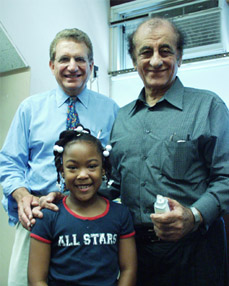NIDCD Grantees Receive Award for SBIR Leadership
September 25, 2006
Shlomo Silman, Ph.D., and Daniel S. Arick, M.D., of Arisil, Inc., are among this year’s winners of the prestigious Tibbetts Award hosted by the Small Business Technology Council with support from federal and private organizations, including NIH, DOD, and NASA. The award is given “in recognition of significant achievements involving technological innovation related to the Small Business Innovation Research Program (SBIR).” Individuals and companies selected for these awards are recognized as having provided outstanding SBIR leadership in the state, region, or nation. The awards will be presented in Washington, D.C. on September 26.

Daniel S. Arick, M.D., (l) and Shlomo Silman, Ph.D., winners of this year’s Tibbetts award, with Tiana, one of the children who participated in their clinical trial of the EarPopper.
Arisil, Inc., was founded to develop the technology called the EarPopper for the non-surgical and non-drug treatment of hearing loss caused by otitis media with effusion (OME) and eustachian tube dysfunction. OME is the accumulation of non-infected fluid in the middle ear. Arisil received funding through NIDCD’s SBIR program for the development and testing of the EarPopper through feasibility and clinical trials in children and adults. The EarPopper is patented and has FDA approval as a medical device available by prescription. This device is a new take on an old theme known as the Politzer maneuver in which a doctor injects air up one nostril of a patient while the second nostril is pinched closed and the patient swallows. During the swallow, the air is diverted into the Eustachian tube, which ventilates the middle ear. The EarPopper differs from the Politzer design because it provides controlled airflow and pressure in a hand-held, battery-operated device that can be used at home.
In a four-year study that included approximately 100 children, 85 percent of the children who used the device over the course of three months had restored hearing. The study suggests that, in certain cases, the Ear Popper may eliminate the need for antibiotics or the placement of surgical tubes as treatments for OME. Each year approximately 2.2 million cases of OME are diagnosed in this country, resulting in an estimated $4 billion in medical costs. For more information on the EarPopper, go to
www.nidcd.nih.gov/health/inside/sum06/pg5.asp
Top